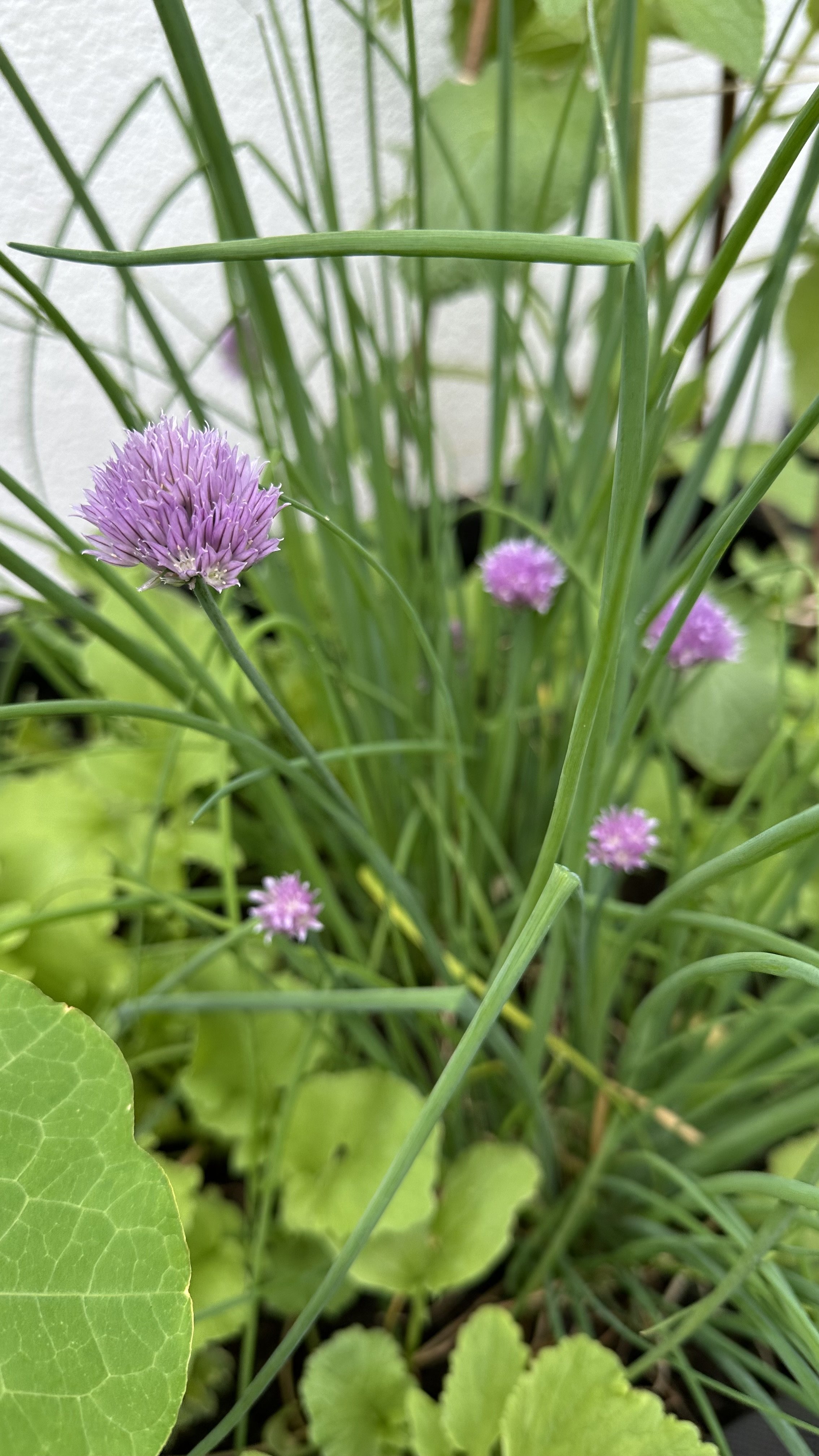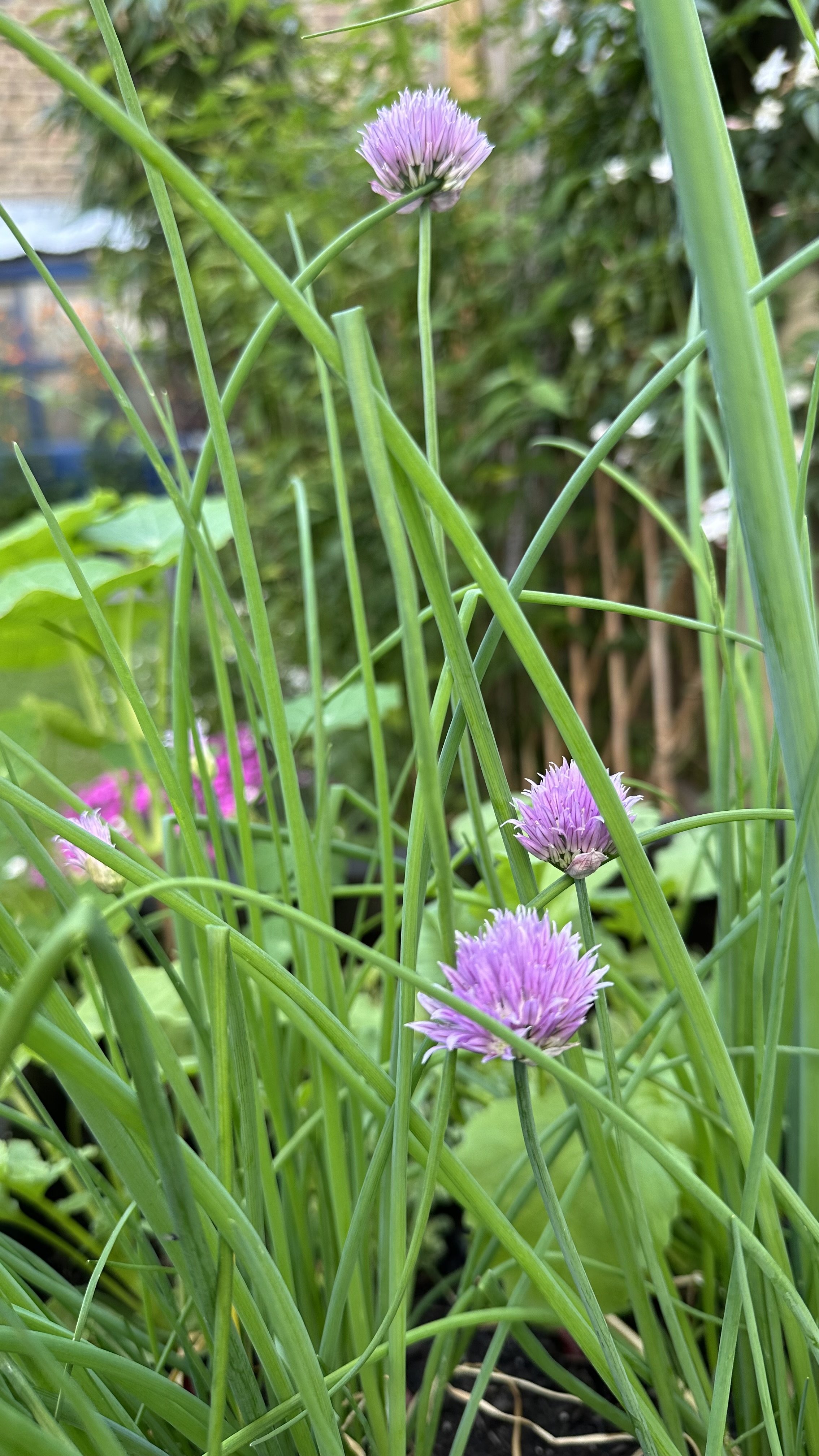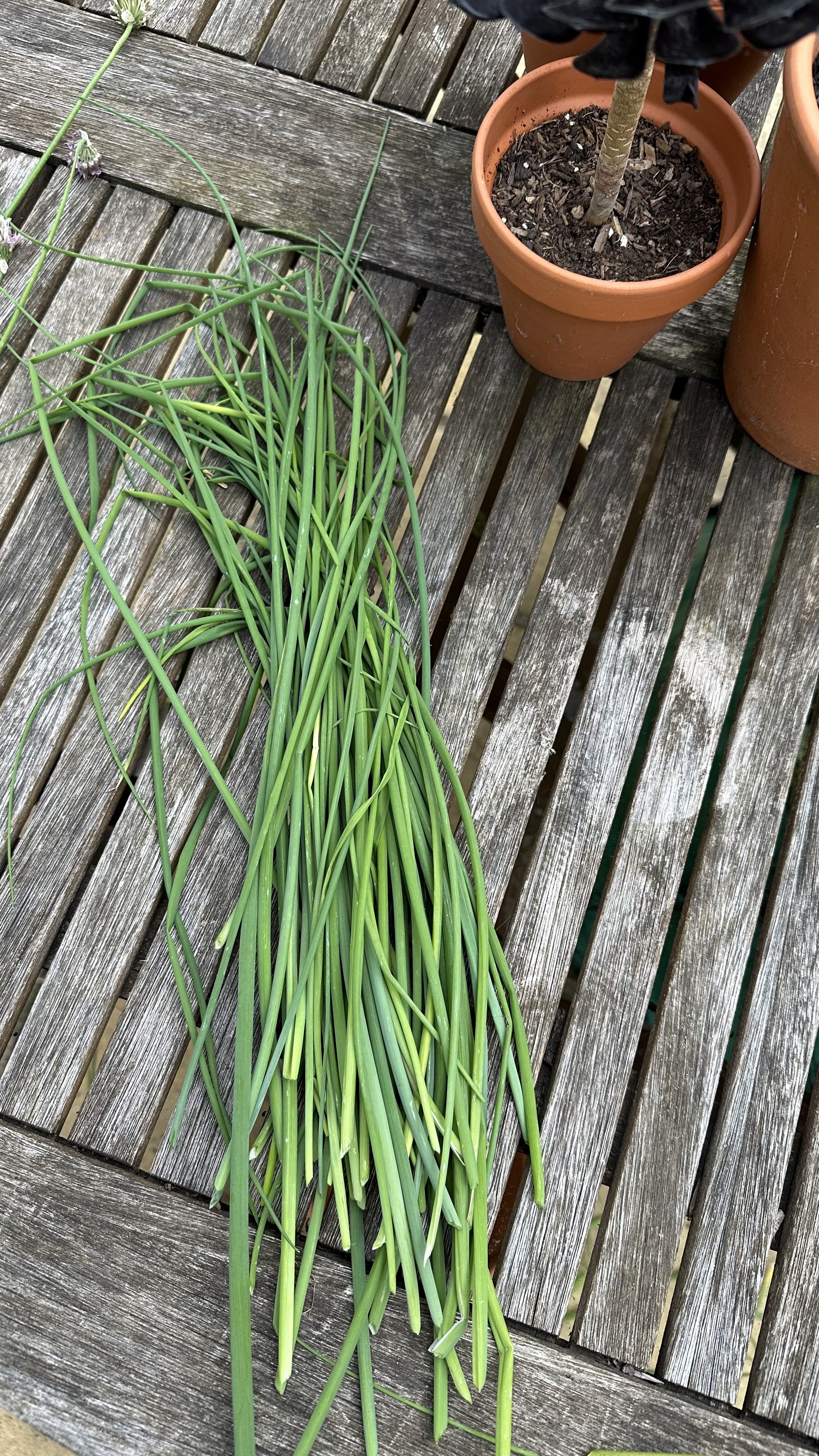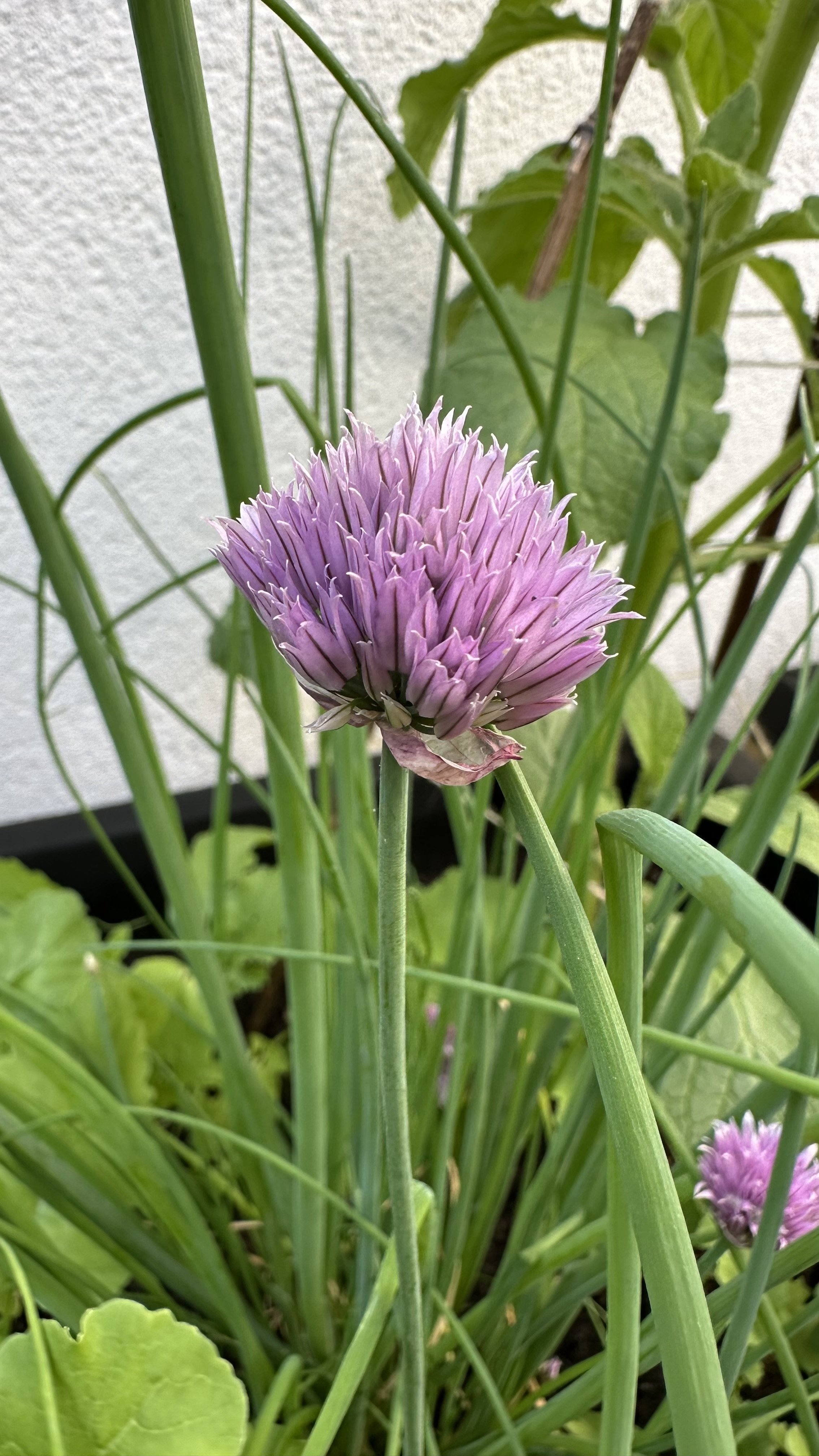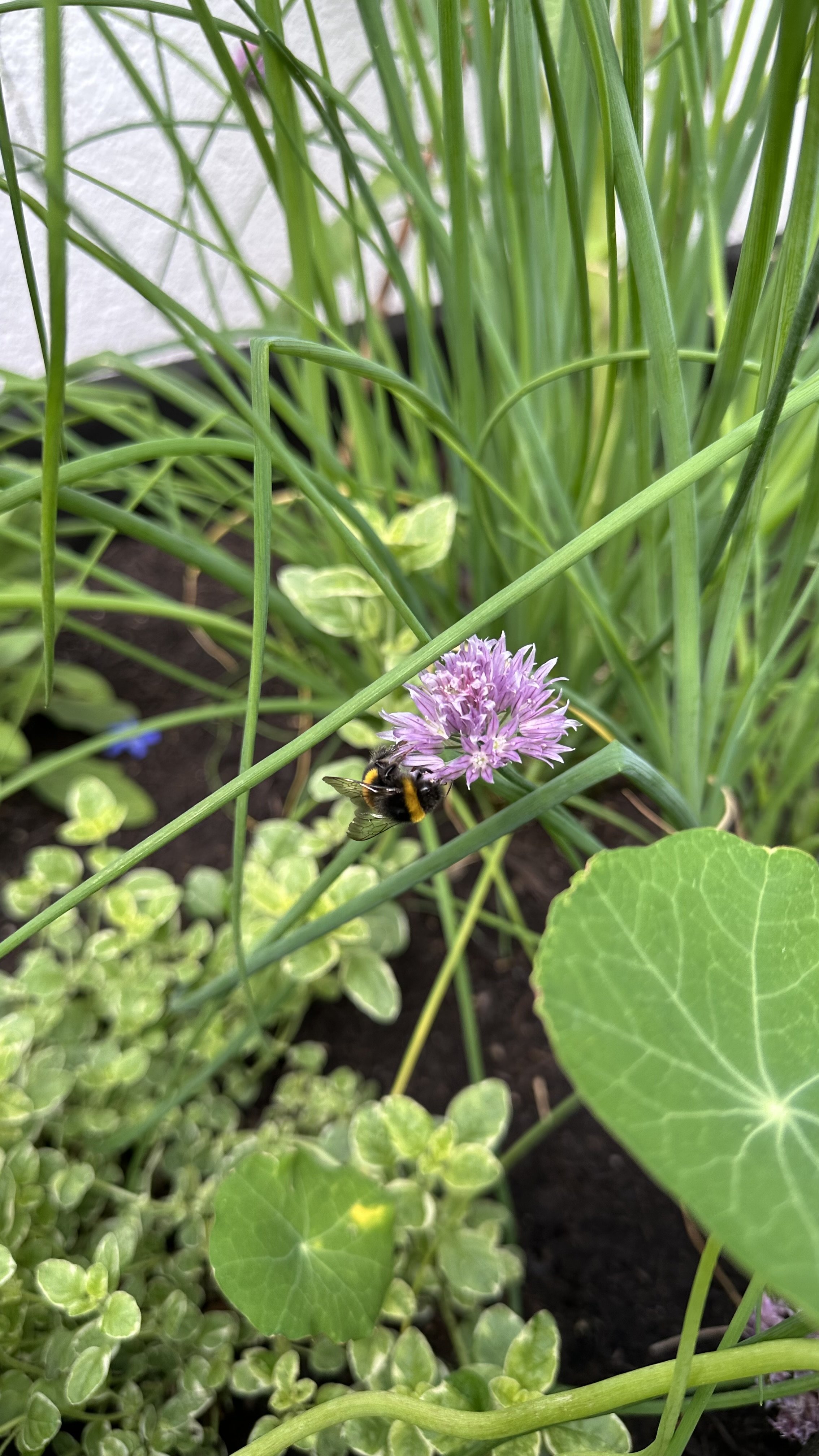Growing Chives in Pots: The Ultimate Guide
This article has links to products that I may make commission from.
Chives, with their delicate green stems and vibrant purple blooms, are more than just a beautiful flower in the garden.
Growing chives in pots brings an added layer of convenience, making them accessible to balcony and container gardeners.
These perennial herbs, known for their mild onion flavor, have been a culinary favorite for centuries.
Whether you're looking to add a fresh chives to homemade dishes or seeking a low-maintenance plant to enhance your herb garden design, chives are a perfect choice.
In this comprehensive guide, we'll explore the ins and outs of potting, caring for, and harvesting chives, ensuring that you can enjoy their beauty and taste year-round.
To learn more about herb gardening, check out my guides:
The Best Chive Companion Plants
Choosing the Right Pot for Your Chives
Selecting the ideal pot is essential for the successful growth of chives.
Here's a detailed breakdown of the considerations to ensure your chives thrive:
Size and Depth:
Why It Matters:
Chives have a relatively shallow root system, but they still need space to spread out and grow without being constrained.
Recommendation:
Opt for a pot that is at least 7-12 inches deep.
This gives the roots ample space to grow while also providing enough soil to retain moisture between watering sessions.
Material:
Benefits of Terracotta:
Terracotta pots are breathable, which means they allow air and moisture to move through the walls.
This can prevent overwatering and root rot issues. They're also sturdy and provide a classic aesthetic appeal.
I love the look of this terracotta pot and it is perfect for growing chives:
Plastic Pots:
These are lightweight and retain moisture better than terracotta.
If you live in a hotter region, plastic might be more appropriate, but ensure good drainage.
I love these plastic pots that look like terracotta pots:
Wooden and Metal Containers:
Wooden pots can give a rustic appeal, while metal ones offer a modern touch.
Just be wary of temperature fluctuations with metal pots, as they can get hot in the sun.
This wooden planter box is perfect for growing chives:
Drainage:
The Importance:
Good drainage is vital to prevent waterlogging, which can harm the chive's roots and lead to diseases.
Features to Look For:
Ensure the pot has multiple drainage holes at the bottom.
If your preferred pot doesn't have holes, you can drill some yourself or layer the bottom with coarse gravel to aid drainage.
Price and Design:
Budgeting:
Pots come in a wide range of prices.
While it's tempting to go for cheaper options, investing in a durable pot can save money in the long run.
Consider the material and longevity when determining the price.
Design Aesthetics:
With a variety of designs, colors, and finishes available in the market, select one that complements your home or garden's aesthetic.
A beautiful pot not only houses the chives but also becomes a decorative piece.
Accessibility and Handling:
Moving Around:
If you're planning to move your chive pots based on sunlight or weather conditions, consider the weight of the pot, especially when filled with soil.
Some pots come with saucers or wheels for easy movement.
Maintenance:
Some pots, especially those with intricate designs, might be harder to clean.
Think about long-term maintenance when making your choice.
Want to learn more about container gardening? Check out my guides:
The Ideal Soil and Compost for Growing Chives
Soil and compost play a pivotal role in the growth and health of chives.
Ensuring the right mix can make the difference between thriving chive plants and ones that struggle.
Let's delve into what makes for the perfect potting environment for chives:
Understanding Chive Preferences:
Soil Texture:
Chives thrive in well-draining soil.
This ensures that the roots receive adequate moisture without the risk of waterlogging.
Soil pH:
Chives prefer a neutral to slightly alkaline soil, with a pH level of around 6.0 to 7.5.
This is the soil pH kit I use to test soil before planting:
Choosing the Potting Mix:
Ready-made Mixes:
There are many high-quality potting mixes available in shops tailored for herbs.
These mixes often contain perlite or vermiculite to aid in drainage.
Here is the potting mix I recommend for growing chives:
DIY Approach:
You can prepare your potting mix by blending garden soil with organic compost and some coarse sand or perlite.
The sand helps improve drainage, a crucial aspect for chives.
Composting for Success:
Organic Matter:
Compost introduces vital organic matter into the soil, which slowly releases nutrients that chives need to grow.
It also enhances the soil's water retention capacity without making it soggy.
Application:
When potting, blend the compost with the potting mix. Later, as the growing season progresses, you can add a top layer of compost to replenish nutrients.
Types of Compost:
Purpose Compost:
A balanced compost specifically tailored for potted plants. It provides a consistent and slow release of nutrients.
Learn more in my guide The Best Compost for Vegetable Gardens.
Organic Compost:
Made from decomposed plant and animal matter.
Worm castings, well-decomposed manure, or composted leaves are excellent options.
Here are the worm castings I recommend using:
Additional Soil Considerations:
Fertilizer:
If your soil is not nutrient-rich or if you notice your chives looking a little lackluster, a mild, balanced fertilizer can be introduced.
Remember, chives don’t need a lot, so use sparingly.
Here is the balanced fertilizer I use:
Monitoring and Adjusting:
Observe Plant Health:
If chive leaves appear yellowish or growth seems stunted, it might indicate nutrient deficiencies.
Addressing the soil and compost composition can often remedy this.
Planting Your Chives
The actual planting process for chives is quite straightforward, but a few key steps and considerations can ensure a bountiful and healthy growth.
Here’s what you need to know:
Starting from Seed vs. Transplanting:
Chive Seeds:
How to Start:
Chive seeds can be sown directly into the pot.
Simply sprinkle the seeds lightly over the soil and cover with a thin layer of compost or soil.
Here are the chive seeds I recommend:
Germination:
Seeds generally germinate within 10-14 days, provided they are kept consistently moist.
Learn more in my guide How Long Does it Take for Seeds to Germinate?
Pros:
Growing from seed can be economical, especially if you plan on having multiple pots.
Plus, there’s the rewarding experience of seeing your plants sprout from tiny seeds.
Transplanting Chive Plants:
How to Start:
If you’re buying young chive plants or dividing mature ones from your garden, ensure a hole deep enough to accommodate the root ball.
Place the plant in and gently pack the soil around.
Pros:
This gives you a head start, as you begin with a mature plant.
Here is where I recommend buying young chive plants:
Positioning and Spacing:
Space Them Out:
If you’re planting multiple chive plants in one pot, ensure they’re spaced at least 6 inches apart.
This provides them ample space to spread out and grow.
Depth is Key:
If transplanting, ensure that the chives are planted at the same depth as they were in their previous container.
Watering After Planting:
Initial Moisture:
Once your seeds or plants are in the pot, water them gently but thoroughly.
This ensures the soil is evenly moist and helps the seeds settle or transplants to establish.
For this, you can use rainwater collected from a water butt.
Considering Growth Stages:
Seedlings:
Once your chive seeds have sprouted, they’ll go through a fragile seedling stage.
Ensure they are kept moist and are not exposed to extreme conditions.
They can be kept in a greenhouse during this phase.
For more watering tips, check out my guide How Often to Water Seedlings.
Maturing Plants:
As your chives grow and establish themselves, their needs will change.
They'll become more resilient and will soon start showing their characteristic mild onion flavor.
Light and Positioning:
Full Sun to Partial Shade:
Chives thrive in full sun but can also tolerate partial shade.
Once planted, position the pot where it can receive at least 6 hours of sunlight daily, like in a south facing garden.
Indoors vs. Outdoors:
If you're growing chives in pots indoors, placing them by a sunny window is ideal.
For outdoor growth, choose a spot in your balcony, patio, or garden that matches their light requirements.
Maintenance and Care:
Regular Trimming:
As chives grow, regularly trim and use the chive leaves to encourage bushier growth.
This not only benefits the plant but provides you with fresh herbs for your culinary endeavors.
Watching Out for Flowers:
Chives will eventually produce beautiful, edible flowers.
While they’re a delightful sight and tasty, consider trimming some of them back to channel the plant's energy into leaf production.
Caring for Your Chives
Chives, while relatively low-maintenance, do benefit from regular attention and care.
Here’s a comprehensive guide on nurturing your potted chives:
Watering Needs:
Consistency is Key:
Chives prefer soil that’s consistently moist but not waterlogged.
Overwatering can lead to root rot, while underwatering may stunt their growth.
Frequency:
During their growing season, particularly in hotter months, check the soil every couple of days. If the top inch feels dry, it's time to water.
Method:
Water slowly and deeply, ensuring that the water reaches the roots.
Using a saucer under your pot can help catch any excess water and prevent messes.
Feeding and Fertilization:
Nutrient Needs:
Chives are not particularly heavy feeders.
However, if you’ve not repotted them in a while or if you notice pale leaves, they might benefit from some additional nutrients.
Fertilization Frequency:
A balanced, slow-release fertilizer can be applied at the beginning of the growing season.
Alternatively, a diluted liquid fertilizer can be given once a month.
Here is the slow-release fertilizer I recommend:
Pruning and Harvesting:
Encouraging Growth:
Regularly trimming and harvesting your chive leaves can stimulate bushier growth.
Simply snip the leaves with scissors, leaving about 2 inches above the soil.
Flower Buds:
As chives produce their edible flowers, you can choose to either enjoy them in your dishes or snip them off to channel more energy into leaf growth.
Pest and Disease Management:
Common Pests:
Chives can occasionally be bothered by aphids or spider mites, especially when grown indoors.
Regularly inspect your plants and treat any infestations early.
Natural Solutions:
Introducing beneficial insects like ladybugs or using a mild insecticidal soap can be effective.
Diseases:
Overwatering or poor drainage can lead to fungal diseases.
Ensuring proper watering practices and a well-draining potting mix can prevent most issues.
Winter Care (Overwintering):
Outdoor Plants:
In regions with harsh winters, consider moving your chive pots indoors or to a protected area like a garage or shed.
Indoor Growth:
Chives grown indoors during winter might need supplemental lighting, as the days are shorter and often gloomier.
Dormant Period:
It's natural for chives to die back and go dormant in the winter.
They will regrow in the spring. During this period, reduce watering.
Re-potting Considerations:
Why and When:
Over time, chives can become root-bound or exhaust the nutrients in their potting mix.
If you notice slowed growth or roots growing out of the drainage holes, it might be time to re-pot.
The Process:
Gently remove the chives from their current pot, separate any crowded clumps, and transplant them into a slightly larger container with fresh potting mix.
To learn about growing onions, check out my guide:
Harvesting and Usage of Chives
Chives are not just an ornamental delight; they're a culinary gem.
Harvesting them at the right time and using them creatively can elevate your meals.
Here’s how you can get the most out of your chive plants:
When to Harvest:
Early Harvest:
Chives can be harvested as soon as they’re about 6 inches tall.
This ensures young, tender shoots that are full of flavor.
Regular Harvesting:
Regular cutting encourages the plants to produce more shoots.
Don’t be afraid to harvest frequently; chives are resilient and bounce back quickly.
How to Harvest:
Snipping Method:
Use clean scissors or garden shears to cut the chives about 1-2 inches above the soil.
This method prevents damage to the plant and encourages regrowth.
Whole Plant Harvest:
If you need a large quantity, you can cut the entire clump down to 2 inches. It will regrow in a few weeks.
Utilizing Chive Flowers:
Edible Beauties:
Not only are the leaves of chives edible, but their flowers are as well.
They provide a milder flavor and can be used as a garnish or in salads.
Flower Vinegar:
Immerse chive blossoms in white vinegar to infuse it with a delicate oniony flavor and a lovely pink hue.
Storing Harvested Chives:
Fresh Storage:
Freshly harvested chives can be stored in the refrigerator for up to a week.
Wrap them in a slightly damp paper towel and place them inside a resealable plastic bag.
Freezing:
For longer storage, you can chop chives and freeze them in an airtight container or bag.
They can also be frozen in water in ice cube trays, making them easy to pop into soups and stews.
Culinary Uses:
Cooking:
Chives have a mild onion flavor and are best added at the end of the cooking process to preserve their taste and vibrant color.
Garnishing:
Sprinkle chopped chives over soups, salads, and baked potatoes for a burst of flavor and a touch of color.
Combinations:
Chives pair well with eggs, cheeses, and seafood. They can be incorporated into omelets, cheese spreads, and dips.
Herb Butter:
Mix finely chopped chives with softened butter, a touch of lemon zest, and a pinch of salt for a delightful herb-infused butter.
Medicinal and Other Uses:
Traditional Medicine:
In some cultures, chives have been used for their purported mild anti-inflammatory and antibacterial properties.
Companion Planting:
In garden design, chives can act as a companion plant. Their pungent smell can deter pests from neighboring plants.
Why Grow Chives in Pots?
Space Efficiency:
Compact Living:
For those with limited yard space, pots provide the perfect solution to grow chives.
Vertical Gardening:
By growing chives in pots, you can leverage vertical space on shelves or hanging planters, optimizing the space you have.
Decorative and Functional:
Aesthetic Appeal:
Potted chives can serve as a decorative element both indoors and outdoors.
Their slender green leaves paired with purple flowers can beautify any space.
Easy Access:
Growing chives in pots, especially near your kitchen or dining area, ensures that fresh herbs are always within arm's reach, ready to be snipped and added to your dishes.
Flexibility and Mobility:
Seasonal Adjustments:
With pots, you can easily move your chives around based on the season.
During harsh summer or winter days, you can move them to shaded areas or indoors to protect them.
Experimentation:
If you're unsure where your chives will thrive best, pots allow you to experiment with different spots without the need to replant.
Pest and Disease Control:
Isolation:
If a plant gets infected or infested, it's easier to isolate and treat when it's in a pot.
This reduces the risk of pests or diseases spreading to other plants.
Better Soil Control:
By using a potting mix, you can ensure that the soil is free from any pathogens or pests right from the start.
Variety:
Multiple Varieties in Limited Space:
If you're keen on growing both common chives and garlic chives, pots allow you to cultivate multiple varieties without needing a lot of ground space.
Themed Herb Gardens:
Potted chives can be part of a themed pot garden, such as an "Italian Herb" garden with basil, oregano, and chives.
FAQs
Do chives grow back after cutting?
Yes, chives are perennial herbs that are known for their resilience.
When you cut or harvest chives, they will grow back, often quite quickly.
In fact, regular harvesting encourages the plant to produce more shoots, leading to a bushier and more productive plant.
Ensure you leave about 1-2 inches of the plant above the soil when cutting to promote healthy regrowth.
Should I let my chives flower?
It depends on your purpose.
Chive flowers are both edible and visually appealing.
They can be a beautiful addition to salads and serve as a unique garnish.
However, if your primary interest is in harvesting the leaves, it's a good idea to snip off the flowers as they appear.
This channels the plant's energy back into leaf production.
If you let them flower and go to seed, the plant might become less vigorous in leaf production for a time.
Does chives need full sun?
Chives thrive best in full sun, which means they prefer at least 6 hours of direct sunlight each day.
That said, they are also quite adaptable and can tolerate partial shade.
If you're growing chives indoors, placing them by a sunny window or providing supplemental light will keep them happy and productive.
How long do chives take to grow?
Chives, when grown from seed, generally take 10-14 days to germinate after sowing.
Once they've sprouted, they'll reach a harvestable size (about 6 inches tall) in a couple of months.
If you're transplanting young chive plants or dividing mature ones, you'll have a head start and can begin harvesting sooner.
How can I use chives in my garden design?
Chives, with their slender green leaves and pom-pom-like purple flowers, can be a delightful aesthetic addition to any garden.
They work well in borders, as part of a herb garden, or even in mixed flower beds.
Their vertical growth can add structure to a garden, and their flowers attract beneficial pollinators like bees.
To learn more about herb gardening, check out my guide How to Start a Raised Bed Herb Garden.
What's the difference between common chives and garlic chives?
Common chives (Allium schoenoprasum) have a mild onion flavor and produce round, purple flowers.
Garlic chives (Allium tuberosum), on the other hand, have a garlic flavor, as their name suggests, and their leaves are flatter and broader.
Garlic chives produce white, star-shaped flowers.
Are chive flowers edible?
Yes, chive flowers are edible and offer a milder flavor compared to the leaves.
They can be used in salads, as garnishes, or even infused in vinegar for a delightful oniony touch.
Growing Allium schoenoprasum, or as we commonly know them, chives, can be an enriching journey for any gardener.
Their versatility and adaptability make them an excellent choice for various settings.
Ensuring that they're planted in well-drained soil is a foundational step towards a thriving chive plant.
Here's to bountiful pots filled with these slender green wonders!




